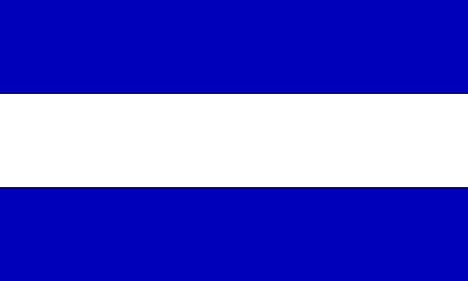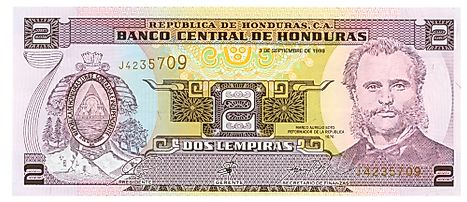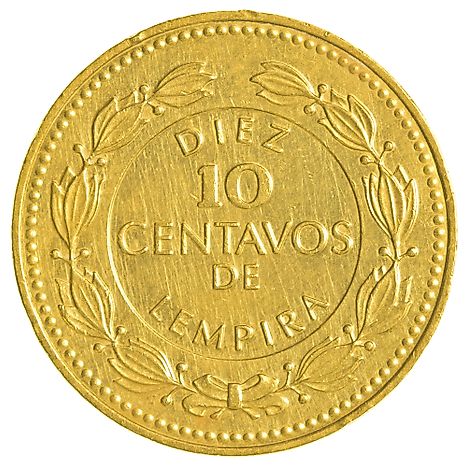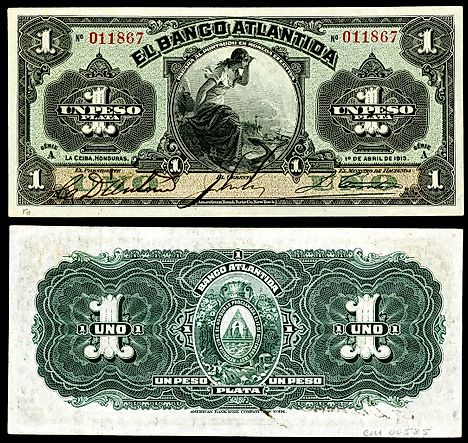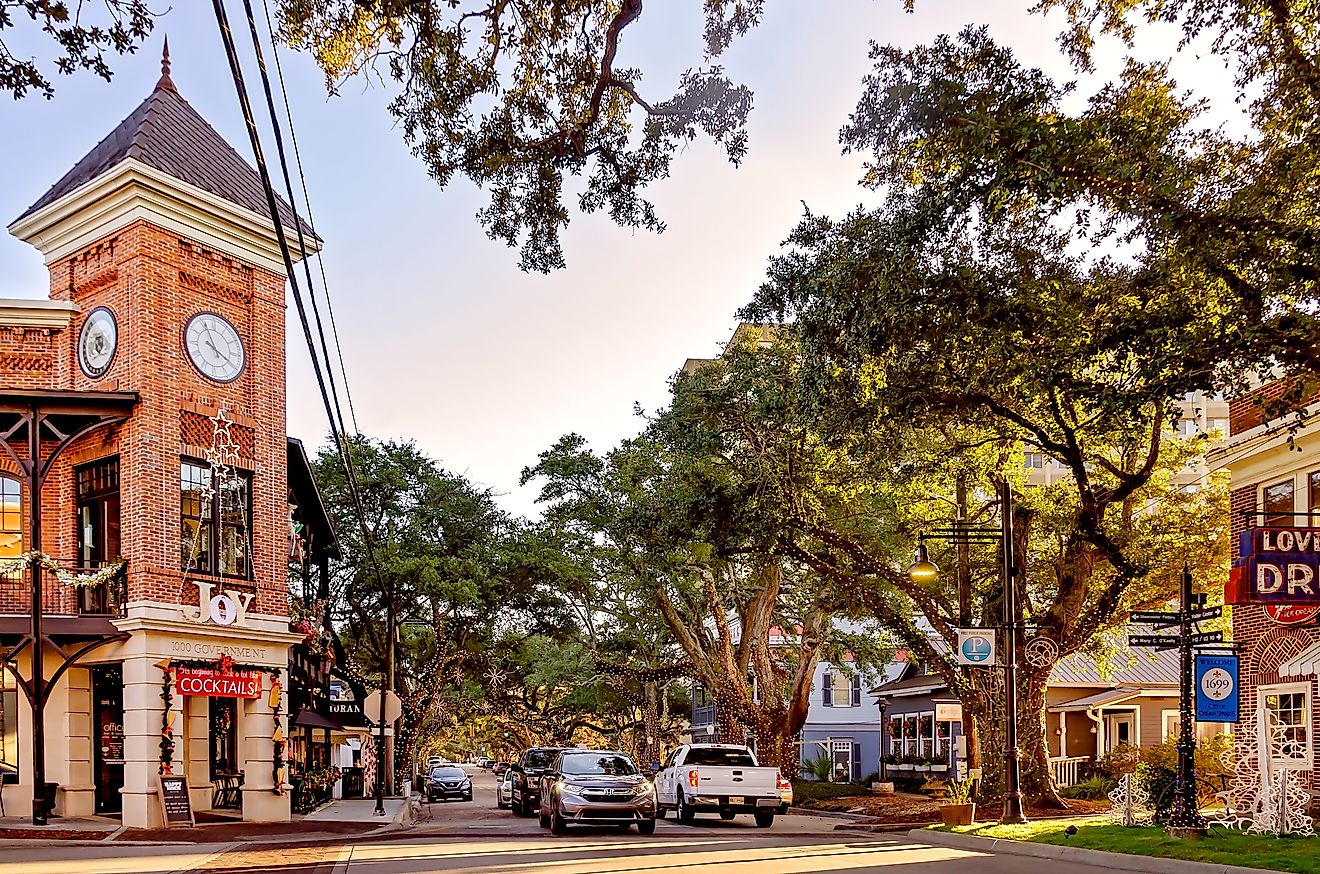Flags, Symbols, & Currencies of Honduras
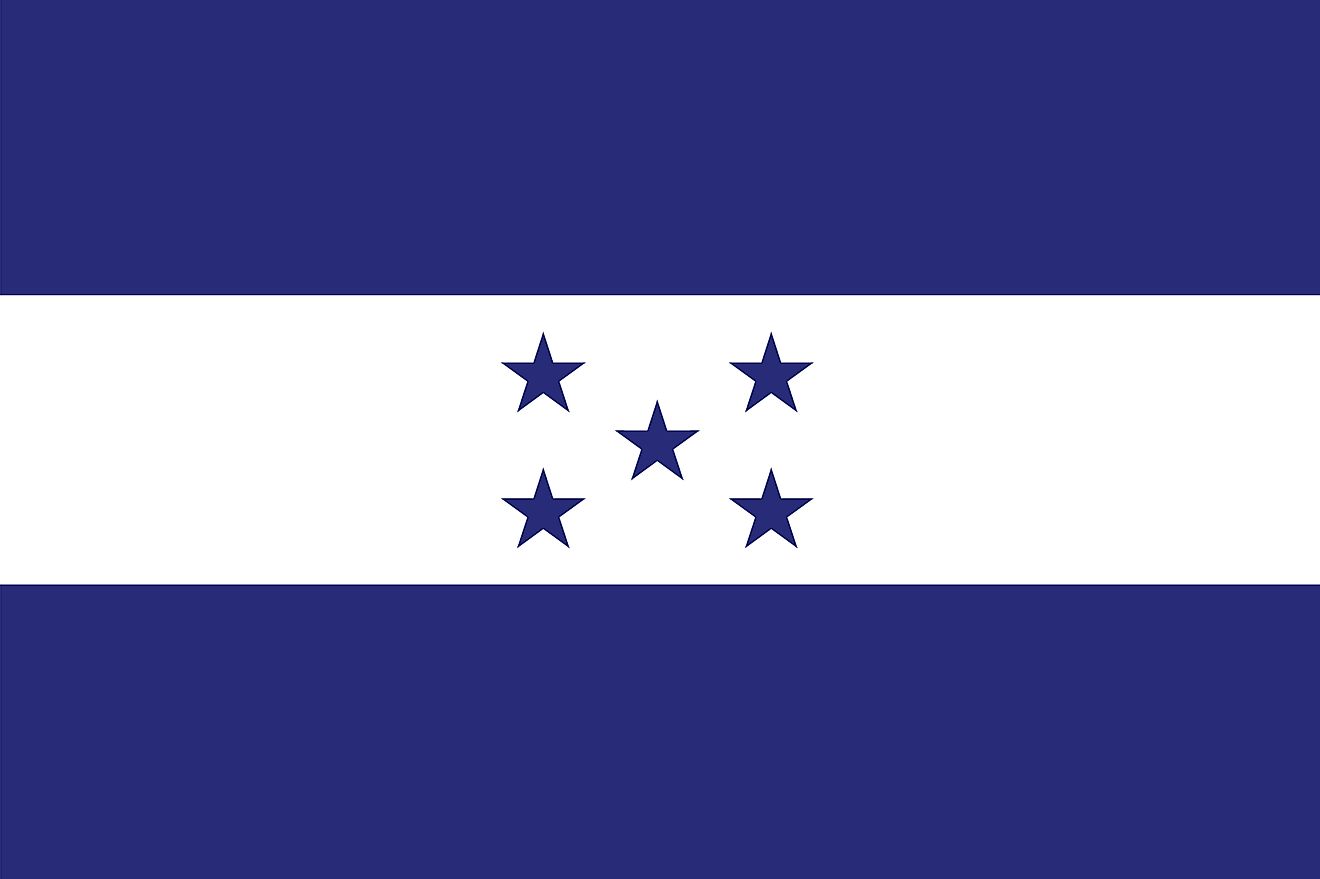
Honduras adopted its national flag in March 1866. However, the flag underwent some modifications in 1898 when five blue stars were added, and has remained unchanged ever since. The design of the flag was inspired by the flag of the Federal Republic of Central America, of which Honduras was a member.
Description
The national flag of Honduras is designed with height to width proportions of 1:2. The flag features a tri-band which runs horizontally. The top and bottom bands are blue and sandwich a white-colored band. The three bands are of equal width. On the middle white band are five stars, arranged to form an “X” pattern. The stars are five-pointed and are all blue. The design is different in the nations’ civil ensign, which retains the proportions and tri-band but also features the country’s coat of arms which is centered on the white band. The five stars are differently organized on the civil ensign, as they form an arc below the coat of arms.
Symbolism
The two blue bands stand for the two oceans (The Pacific and the Caribbean Sea) that surround the country. The blue color also represents the bonds of brotherhood or the blue skies seen over the country. The middle white band represents Honduras’ land area that sits between two oceans. White is also said to stand for the virtues of purity, peace, and prosperity among the inhabitants. The five stars stand for the five countries that made up the now-defunct Federal Republic of Central America. The representation of these countries shows the optimism in Honduras on the revival of the Federal Republic of Central America.
History of the Flag
When Honduras became part of the United Provinces of Central America in 1823, it adopted its flag, which was tricolor flag of light blue (top), white, and light blue, defaced with a seal. However, the union was officially dissolved in 1840, by which Honduras had adopted a tricolor flag of blue (top), white, and blue. The new flag was used between 1839 and 1866. In 1866, five blue stars were added to the white band and the flag adopted as Hondura's official flag. In 1898, the blue stars were changed to yellow stars and the design was used until 1949 when the blue stars were reintroduced.
Symbols of Honduras
National Coat of Arms of Honduras

The Coat of Arms closely resembles that which neighboring Guatemala had in 1843. It features features a white oval encapsulating a volcano, a triangle, two towers which are linked by a rainbow, and the sun. The rainbow and sun inside the triangle resemble the Masonic Eye. On the white oval is the inscription “Republica De Honduras Libre, Soberana E Independiente 15 De Septiembre 1821” which translates to “Republic of Honduras, Free, Sovereign, Independent September 15th, 1821”. The compartment features limestone cliffs that stand between six deciduous trees, three oak trees, and three pine trees. Two mines appear to go through the left side of the mountain range. There are different tools on the bottom of the white circle; a sledgehammer, a wedge, a hammer, and a drill. The crest features a quiver of differently colored arrows set on “the horns of plenty” which have two bunches of flowers on their edges.
Symbolism
The triangle represents freedom and equality in the country. The two towers are said to represent the preparedness of the country to defend itself, and also stand for the independence of the country. The quiver of arrows is in honor of the native inhabitants of Honduras. The mines and mining tools on the compartment represent the mining industry in the country, and the six deciduous trees are incorporated, symbolize the abundance of natural wealth in Honduras. The inscription on the white oval indicates the date when the country gained independence.
National Anthem
- Anthem Title: Himno Nacional de Honduras (National Anthem of Honduras)
- Music composer: Carlos Hartling
- Lyricist: Augusto Constantino Coello
- Date of Adoption: 1915
The national anthem of Honduras was composed by Carlos Hartling and lyrics written by Augusto Constantino Coello. The anthem is a brief chronology of Honduran history. It was adopted as the country's national anthem in 1915, following presidential decree 42. Although the National Anthem of Hondiras has seven solos and a chorus, only the 7th solo and the chorus are sung during official function.
Himno Nacional de Honduras (Spanish)
Coro
Tu bandera, tu bandera es un lampo de cielo
Por un bloque, por un bloque de nieve cruzado;
Y se ven en su fondo sagrado
Cinco estrellas de pálido azul;
En tu emblema, que un mar rumoroso
Con sus ondas bravías escuda,
De un volcán, de un volcán tras la cima desnuda
Hay un astro, hay un astro de nítida luz.
India virgen y hermosa dormías
De tus mares al canto sonoro,
Cuando echada en tus cuencas de oro
El audaz navegante te halló;
Y al mirar tu belleza extasiado
Al influjo ideal de tu encanto,
La orla azul de tu espléndido manto
Con un beso de amor consagró.
De un país donde el sol se levanta,
Mas allá del Atlante azulado,
Aquel hombre te había soñado
Y en tu busca a la mar se lanzó.
Cuando erguiste la pálida frente,
En la viva ansiedad de tu anhelo,
Bajo el dombo gentil de tu cielo
Ya flotaba un extraño pendón.
Era inutil que el indio tu amado
Se aprestara a la lucha con ira,
Porque envuelto en su sangre Lempira,
En la noche profunda se hundió;
Y de la épica hazaña, en memoria,
La leyenda tan sólo ha guardado
De un sepulcro el lugar ignorado
Y el severo perfil de un peñón.
Por tres siglos tus hijos oyeron
El mandato imperioso del amo;
Por tres siglos tu inútil reclamo
En la atmosfera azul se perdió;
Pero un día gloria tu oído
Percibió, poderoso y distante,
Que allá lejos, por sobre el Atlante,
Indignado rugía un León.
Era Francia, la libre, la heroica,
Que en su sueño de siglos dormida
Despertaba iracunda a la vida
Al reclamo viril de Dantón:
Era Francia, que enviaba a la muerte
La cabeza del Rey consagrado,
Y que alzaba soberbia a su lado,
El altar de la diosa razón.
Tú también, ¡oh mi patria!, te alzaste
De tu sueño servil y profundo;
Tú también enseñaste al mundo
Destrozado el infame eslabón.
Y en tu suelo bendito, tras la alta
Cabellera del monte salvaje,
Como un ave de negro plumaje,
La colonia fugaz se perdió.
Por guardar ese emblema divino,
Marcharemos Oh! Patria a la muerte,
Generosa será nuestra suerte,
Si morimos pensando en tu amor.
Defendiendo tu santa bandera
Y en tus pliegues gloriosos cubiertos,
Serán muchos, Honduras tus muertos,
Pero todos caerán con honor.
National Anthem of Honduras
Chorus
Your flag is a splendour of sky
Crossed with a band of snow;
And there can be seen, in its sacred depths,
Five pale blue stars.
In your emblem, which a rough sea
With its wild waves protects,
Behind the bare summit of a volcano,
A star brightly shines.
Like an Indian maiden you have been sleeping,
Lulled by the resonant song of your seas,
When, set in your golden valleys,
The bold navigator found you;
And on seeing, enraptured, your beauty,
And feeling your enchantment,
He dedicated a kiss of love to the blue hem
of your splendid mantle.
From a country where the sun rises,
Beyond the blue Atlantic,
That man who had dreamt you
In search of you he launched to sea.
When you raised your pale forehead,
In the lively anxiousness of your hope,
Under the gentle dome of your sky
Already floated a strange banner.
It was useless that your beloved Indian
Rushed into the fight with ire,
Because, covered with his blood, Lempira,
In the deep night he sank;
And of the heroic deed, in memory,
The legend alone has kept
A sepulcher in a forgotten place,
And the severe profile of a mountain peak.
For three centuries your children heard
The imperious mandate of the master;
For three centuries your useless complaint
In the blue atmosphere was lost
But one glorious day your ear
Perceived, powerful and distant,
That there, far away, over the Atlantic,
Indignantly, a lion roared.
It was France, the free, the heroic,
Which in its dreams of centuries slept,
Awoke irate to life
At the virile protest of Danton:
It was France, who sent to the death
The head of the consecrated King,
And which built up proudly at its side,
The altar of the goddess of Reason.
You also, oh my country!, arose
From your servile deep sleep;
You also showed the world
The infamous shackle destroyed.
And in your blessed soil, behind the tall
Hair of the wild jungle,
Like a bird of black feathers,
The fleeting colony was lost.
To guard this sacred emblem
We shall march, oh fatherland, to our death;
Our death will be honoured
If we die thinking of your love.
Having defended your holy flag,
And shrouded in its glorious folds,
Many, Honduras, shall die for you,
But shall fall in honour.
The Currency of Honduras is the Honduran lempira
Honduras is the second largest Spanish-speaking country in Central America. In the recent years, the country’s economy has grown at an average annual rate of 7%, which is the highest growth rate in Latin America. The Central Bank of Honduras has played a crucial role in stabilizing economic growth in the country through regular controls of the banking sector. The country's proximity to the Caribbean Sea and Pacific Ocean makes it an attractive business hub. This resulted in the government pronouncing San Pedro as a tax-free zone, allowing international companies to invest immensely in the country. Due to the influence of these international companies, there is a wide supply of US dollars in Honduras. However, the official currency is the Honduran lempira, coded as HNL and symbolized as L.
Lempira Coins
The first lempira coins were issued for circulation in 1931 in denominations of 5, 20, and 50 centavos. In 1932, the 10 centavos coin was introduced, and later in 1939, the 1 centavo coin was distributed for circulation. Lempira coins were initially minted in silver, but were replaced with cupro-nickel in 1967. With the devaluation of the coins over the years against the US dollar, the 1 and 2 centavo coins were phased out in 1974 and 1998, respectively, leaving 5, 10, 20, and 50 coins in circulation.
Lempira Banknotes
Banknotes were first printed and distributed in Honduras in 1932 by the Bank of Honduras and the Banco Atlántida in denominations of 1, 2, 5, 10 and 20 lempira. However, in 1950, the Bank of Honduras annexed the production and printing of paper money and introduced the 50 lempira note in 1951, and the 100 lempira note in 1975. In 1995, the bank minted the 500 lempira note. More recently, a new 20 lempira note began to circulate in 2010 and is printed from a polymer base.
The different denominations of lempira banknotes feature images of prominent leaders in the country. Cacique Lempira is the most common figure, and is featured on the 1 lempira note. Marco Aurelio Soto, former Honduran President, is featured on the 2 lempira coin, while the conqueror of the La Trinidad Battle, Francisco Morazán, is featured on the 5 lempira coin. Other former presidents, such as Jose Cabañas and Manual Galvez, have their portraits on the 10 and 50 lempira coins, respectively. The country’s opposition leader, Dionisio de Herrera, has his portrait featured on the 20 lempira bill, while Jose Cecilio, a renowned philosopher is featured on the 100 lempira note, and biographer Rosa Ramon’s portrait is printed on the 500 lempira note.
Another notable feature of lempira banknotes is that they come in different colors making them easy to differentiate: L1 (red); L2 (purple); L5 (dark gray); L10 (brown); L20 (green); L50 (blue); L100 (yellow); and L500 (magenta).
History of the Honduran Lempira
The Honduran lempira was first issued in 1931 in place of the Honduran peso, the formal currency at the time. The currency is named after the 16th century chief, cacique Lempira, of the indigenous Indian Lenca community, who led the resistance movement against Spanish rule. The currency began trading in the Honduran Exchange Market in the late 1980s against the US dollar, which was the base currency, at 20 cents. The currency has continued to gain value and is currently trading at HNL23.44 against the US dollar.
Historical Currencies of Honduras
Lempira currency was introduced to replace the peso, which was Hondura's official currency between 1862 and 1931. Peso was the curency that replace real and was subdivided into 8 reals. The coins were minted from copper, gold, and silver, and were issued in the denominatons of 1, 2, 4, and 8 (copper), 5, 10, 25, and 50 (silver), and 1 (gold). Real was the currency before peso and circulated in two forms: Spanish colonial real (before 1824) and Central American Republic real (1824 to 1832). Honduran real was introduced in 1832 and was isued as the currency until 1862.
